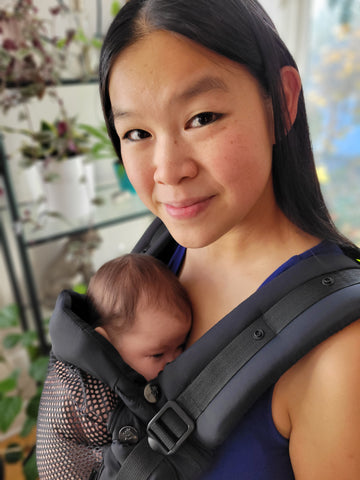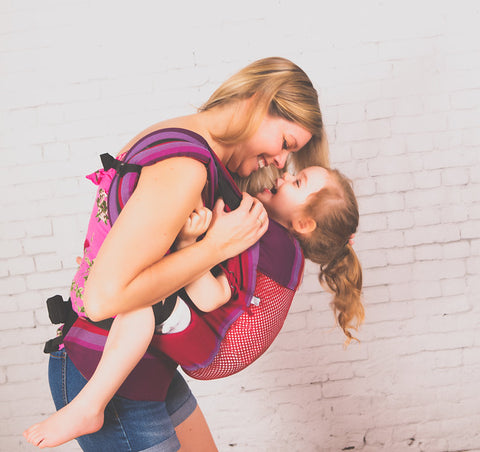5 tips for safe babywearing
Although the benefits of babywearing greatly surpass its risk of injury, some parents have doubts regarding the practice. It’s normal! Our little ones seem so fragile… However, even if its risks are minimal, it’s always better to be safe than sorry. Here are some elements to take into consideration for safe babywearing.
1. Obey the age restrictions of the baby carrier’s model
With the exception of the Bambino, all baby carriers from Chimpäroo can be used with babies from birth and as soon as they reach 8 lbs, which is when the conditions for safe babywearing are all met! Below this weight, the advice of a healthcare professional is recommended for an evaluation of the situation.
2. Make sure the baby carrier is in good condition

Every time you use a baby carrier, verify its condition. Make sure that no seam is coming undone, that no strap is torn and that no component has broken. You should also verify that ties are tightly tied and, for models that use rings, that the fabric can’t slip through.
After two years of regular use, it’s likely that your baby carrier will have enough wear to remain safe to use. Vigilance becomes important at this point. Chimparöo offers a repair service. You can reach out to us if you discover a tear in a fabric or a strap, a broken component, or a seam coming undone or some other problem threatening the safety of the baby carrier’s use. If the repair isn’t covered by our warranty, fees for its repair and shipping will have to be paid.
However, most of our textiles are made of natural cotton fibre or linen are very durable and do not deteriorate rapidly over time. Our baby wraps can definitely remain safe to use for years and years, and can easily be passed down from generation to generation.
Photo: A mother with the versatile EvöAir baby carrier.
3. Verify the position your baby while carrying him
Make sure that your baby breathes comfortably and that you can see its face at all times. His chin should not be stuck against his chest. Make sure that his face is not leaning against the fabric of the baby carrier, your body or your clothes.
For sitting positions, the back needs to have good support and the knees should be lifted up above the baby’s bottom.Carry your baby at a good height and as close to your body as possible. To avoid restricting blood flow, the opening for the legs should not be too tight, and to avoid the danger of the baby slipping through, should not be too wide either.
For more information on carrying positions to adopt, read this article. We invite you to join us on our Facebook Live (fr) hosted by Chimparöo's founder.
4. Choose your baby carrier’s model carefully

Choose a model adapted to your baby’s size. Some models of baby carriers are designed to be comfortable and safe for babies under 18 months. The Stretchy wrap, the Snüg and the PöpNgo are specially adapted for babies of that age group. Beyond 18 months, you’ll prefer the Mei Tai, which is more comfortable up to about 2-3 years old (45 lbs). For more support, go for a Multi 2.0, an EvöAir or a Bambino, which will all allow you to carry a child up to 4-5 years (65 lbs).
Also consider choosing a model that fits your size. Refer to the size chart of each product on Chimparöo's website. All of our models can adapt themselves to any parent’s size. Should you not find a baby carrier suitable for you, in most cases, modify or make a customized version. Babywearing is possible for all parents, no matter their size or weight. Contact us to know more!
Photo: With the Bämbino Air, carrying your child has never been so much fun!
5. Remain vigilant
Never leave your baby alone in its baby carrier and be mindful of possible dangers. Your baby should not get hit by nearby objects or obstacles. To avoid the risk of stumbling and falling while carrying your baby, be careful when walkinFoire aux questionsg on rough terrain or in cluttered spaces.
Do not carry your baby while doing tasks where it could be injured : cooking, drinking a hot beverage, taking heavy objects from high shelves, riding a bike, climbing on a chair, running, skating, driving a car are all exemple to avoid.
Do not carry your baby when in bad health. Some substances can cause problems to your balance, your awareness or make you dizzy. You should also not lie down with the baby carrier.
In winter, be careful when walking on icy sidewalks. Wear ice cleats under your boots. Avoid dangerous terrain where you could slip and fall. Protect your baby from the cold weather, particularly your baby’s extremities. Opt for front carrying positions, since your baby will be more vulnerable to the elements on your back. Do not make your baby’s breathing more difficult by covering him too much with your coat. Keep enough free space for proper air circulation.
On our YouTube page and our Frequently asked questions, you'll find interesting resources to develop your babywearing techniques. You can also contact us here.
Other recommendations for safe babywearing are also available on Health Canada's pages and on Naître et grandir (also in english).

Photo: The Snüg sling is ideal for the skin-to-skin technique.
